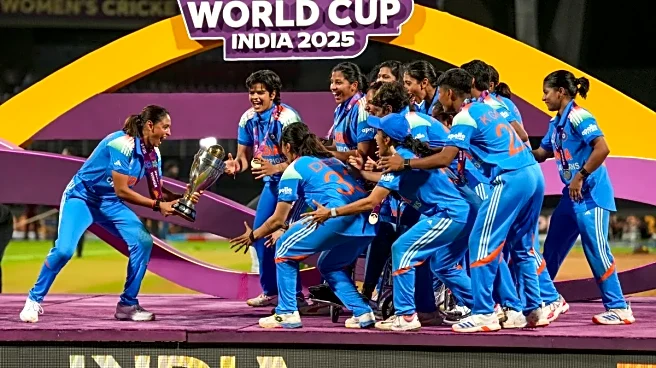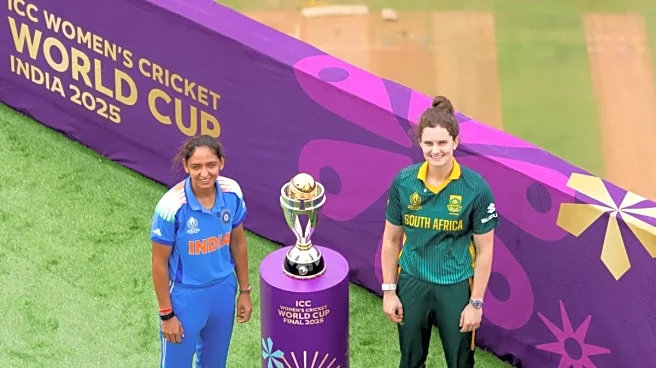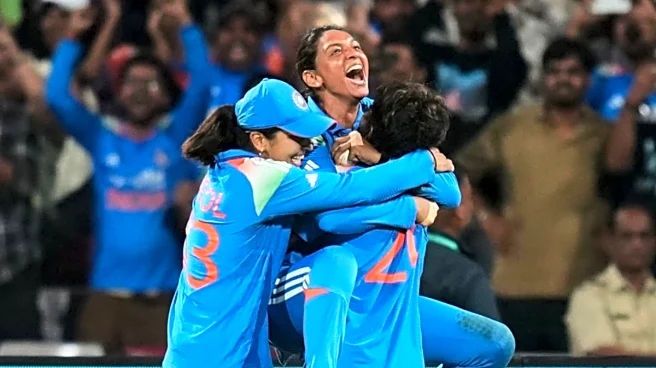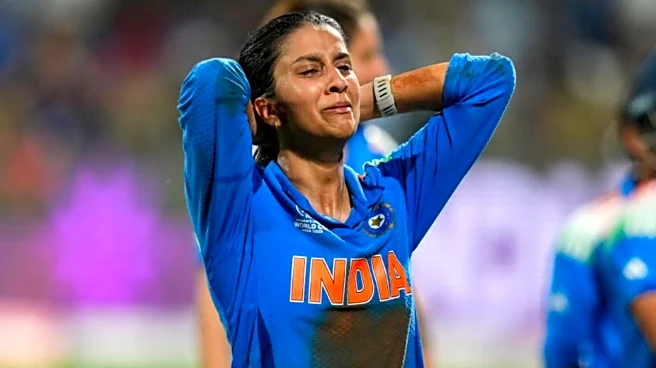History herself arrived in bridal makeup to script history at the stroke of midnight on November 2 (12:03 am, November 3, to be precise), when India lifted its maiden ICC One Day Women’s World Cup Trophy,
defeating South Africa by 52 runs at DY Patil Stadium in Navi Mumbai. To reach where they reached, Indian cricketers defeated both the rain god and their internal demons to make the audacious dream come true.
There is only one parallel in the cricketing annals to this stupendous feat: the reimagining moment of the Indian Cricket team, led by Kapil Dev, holding their maiden Prudential World Cup Trophy aloft on June 25, 1983, at Lord’s Cricket Ground in London after defeating the mighty West Indies by 43 runs.
Only Third Time in History
It is ironical that Bharat, the cricketing powerhouse, has won the ICC ODI World Cup only thrice in more than five decades. The first win came in 1983 when India beat the West Indies in the final. It took close to three decades for India to win the second ODI World Cup after they defeated Sri Lanka in the final in 2011. And it has taken 52 years to win the third ODI World Cup in 2025.
But there is a difference.
While the first two World Cup wins were won by the men’s team, the cup in 2025 was lifted by the daughters of Bharat against all odds.
The taste of the victory was sweeter for the four-time ODI Asia Cup Champions (2004, 2005-06, 2006, 2008) as it came after two prior heart-wrenching defeats in the final – losing to Australia by 98 runs in 2005 and losing to England by 9 runs in 2017 before beating South Africa by 52 runs in 2025.
Beating the Odds
Getting into the tournament, Bharat was ranked 3rd in the ODI team ranking. The ones who were fancied to win the tournament were Australia (7 times Champion) and England (4 times Champion) in the 13 editions of the ODI World Cup. The only other team that has won the ODI World Cup was New Zealand in 2000, which defeated Australia in the final.
Despite two early confidence-building victories over Sri Lanka and Pakistan, the team, already reeling under the expectations of the home crowd, was almost knocked out of the tournament, as it was brought to its knees with three consecutive defeats – against South Africa, Australia, and England – in the league stage.
The Turnaround Heroes
It was at this juncture that, powering on the blistering centuries by Smriti Mandhana (109, 95 balls) and Pratika Rawal (122, 132 balls) and the mesmerising knock of 76 runs off 55 balls by Jemimah Jessica Rodrigues, India racked up 340 for 3 against New Zealand, defeating it by 69 runs to clinch the fourth spot in the semi-final lineup.
Though the last group match against Bangladesh was washed out, it brought a heart-wrenching tournament ending to Pratika Rawal, the turnaround hero, in the tournament. The unfortunate injury helped 21-year-old Shafali Verma parachute into the playing eleven out of nowhere – out of the one-day team for more than a year, she was not even part of the reserve.
Reaching the Summit
The Indian cricket team pulled off a world record run chase to stun defending champions Australia by five wickets in the semi-finals at the DY Patil Stadium in Navi Mumbai on Thursday, particularly after Australia, the world No. 1 team in the format, rode on a Phoebe Litchfield (119 off 93 balls) century to post a massive total of 338 on the board batting first.
But Jemimah Rodriguez and skipper Harmanpreet Kaur had other ideas.
India, third in the rankings, responded with what is now the new record for the highest run chase in women’s ODI cricket history, thanks to a century by Jemimah Rodrigues (127 not out) and a well-made 89 from captain Harmanpreet Kaur. Their 167-run partnership – the highest against Australia in Women’s World Cups – was finally broken in the 36th over after Harmanpreet was caught by Gardner while trying to go after Sutherland.
But Jemimah held up one end while Richa Ghosh (26 runs off 16 balls) and Amanjot Kaur (15 not out off 8) saw off a memorable win under the floodlights at the DY Patil Stadium. This was only India’s 12th win over Australia in the format in 61 matches. Also, the last time Australia lost a match in the Women’s ODI World Cup was also against India in the 2017 semis.
Interestingly, the previous highest successful women’s ODI run chase was registered by Australia against India earlier in the tournament.
This record-breaking chase brought Bharat to the summit clash with South Africa, which had exorcised their own demon by vanquishing England in the first semi-final.
The Party Begins
Before talking of the nitty-gritty of the summit clash, I begin with the moment that launched the whole night celebration by Bharatiyas of all hues, that brought laurels of applause led by Prime Minister Narendra Modi and President Draupadi Murmu, and that led BCCI to announce a whopping Rs 51 crore purse to the winning Indian team.
It was 12:03 AM on November 3. Over 46, ball number 3. Low full toss ball just outside the off stump by Deepti Sharma, de Klerk backs away, trying to go inside out, slices it towards extra cover and Harmanpreet, running back, takes it over her shoulder.
And this game ends, rather fittingly, with Harmanpreet taking the catch, and with Deepti, producing one of the all-time great World Cup final displays, picking up the wicket.
And the party begins. 144 crore Bharatiyas are choked with emotion, thrilled beyond words. This is the moment they have been waiting for. This is the moment they felt they were perhaps going to be denied when they lost three matches in a row. But now, that does not matter. Nothing else matters. India have done it. And they have done it in front of their fans. Runner-up South Africa came into the final chasing history, just like India, and their skipper gave it a proper rattle too. But in the end, they just could not muster enough of a chase!
It’s Bharat’s moment of glory. Well played, South Africa. Thy time will come.
While the end matters most, how did Bharat get there, particularly in the summing clash?
Heroes of the Final
The hero of the final was the indomitable Shafali Verma, parachuted straight from Surat in the semi-final against Australia (where she had a forgettable outing as she scored a lowly 10 runs), who at the age of 21 years and 272 days, became the youngest to score a half-century in an ODI World Cup final – men or women. Also, her brisk-paced 87 became the highest score by an Indian opener, men or women, in a World Cup final, eclipsing Virendra Sehwag’s 82 (2003) and Punam Raut’s 86 (2017).
She set the bar high by adding 104 runs with Smriti Mandhana (45) in 102 balls to set the stage for Deepti Sharma (58) and Richa Ghosh (34) with useful contribution from Jemimah (24) and Harmanpreet (20) to set up the second-highest World Cup final total of 298.
The icing on the cake was the two-wicket haul by Shafali that brought India back in the hunt in the final. But the destroyer-in-chief was Deepti Sharma with her fifer that included the scalp of the dangerous South Africa captain, who achieved her second consecutive century mark of 101 in the final.
It was befitting that Shafali was adjudged player of the match and Deepti (with her 200 plus runs and 22 wickets) player of the series. Smriti Mandhana showed her class by scoring 434 runs, highest ever by an Indian in a single edition and apart from Deepti emerging highest wicket taker of the tournament with 22 scalps, even Sri Charani, with 14 wickets, emerged the fourth biggest wicket taker. Richa Ghosh stamped her authority by becoming one with highest number of sixes in a single edition of the World Cup.
Ecstasy Moment
And what a moment of ecstasy it was before a 35,000 full stadium crowd and crores of Bharatiyas watching the game on the TV. The moment came right when Sunday broke into Monday and these 16 players, including Pratika Rawal who joined the team in celebrations, sitting in a wheelchair, wrote their names in history books, by bringing eternal glory to Bharat. This moment will perennially stay etched in history, encouraging thousands of boys and girls to take up cricket and other sports. Many of the youngsters who brought home the cup were playing in the World Cup for the first time.
Memory Relived
Sachin Tendulkar, Rohit Sharma, Nita Ambani, ICC Chief Jay Shah with women cricketing greats of yesteryears were all in the stands when history was scripted.
I was holed out before my TV screen in my hotel, Taj Vivanta at Begumpet, Hyderabad, sipping incessant cups of ginger tea till 2 AM, surcharged with emotions, unable to either speak or sleep.
For me, it was reliving the memory moment as well. I vividly recall being part of the 25,000 crowd that roared at Moin-ul Haq stadium in Patna on Friday, November 19, 1976, when the Indian Women’s cricket team led by Shantha Rangaswami recorded its first ever Test victory, defeating West Indies – the victory was clinched when Diana Edulji hit the winning run before the roaring crowd in the fourth Test match of the six-game series against West Indies in Patna. The first World Cup has come home to Bharat, 50 years after it won that first test against West Indies.
It was a historic win for the Indian women’s cricket team in its infancy then as the Albee’s pioneering women’s cricket club was founded in Bombay only in 1969 and inspirational Mahendra Kumar Sharma managed to set up the Women’s Cricket Association of India (WCAI) only in 1973 – it was not until 2006 that the WCAI was merged with the Board of Control of Cricket India (BCCI).
Make no mistake, it is the same Bharatiya team who could not play the inaugural Women’s World Cup in 1973 because they could not cobble together a team and had to skip the 1988 World Cup because they could not manage either money or a sponsor despite having made the historical debut in the World Cup as host in 1978 and despite having defeated an International XI and England in the 1982 World Cup.
The scaling of the summit story of the daughters of Bharat is a nostalgic moment. Emotion choked Harmanpreet Kaur, who rightly said, it was just the beginning. But Indian women cricketers have endured it all, living in dormitories to play tournaments, not being able to afford cricketing kits (in early days the entire team would have 2-3 bats), going empty stomach, no match fee, or no money, being branded not professional players to crore of worth contract in WPLs and now Rs 51 crore BCCI bonanza apart from the winning purse.
Well done, daughters of Bharat in Blue. You are an inspiration for 144 crore Bharatiyas. Posterity will not only salute you forever but 16 of you will be the toast of the nation for decades to come and inspire generations to come.
The author is a multidisciplinary thought leader with Action Bias, India-based international impact consultant, and keen watcher of changing national and international scenarios. He works as president, advisory services of consulting company BARSYL. Views expressed in the above piece are personal and solely those of the author. They do not necessarily reflect News18’s views.












